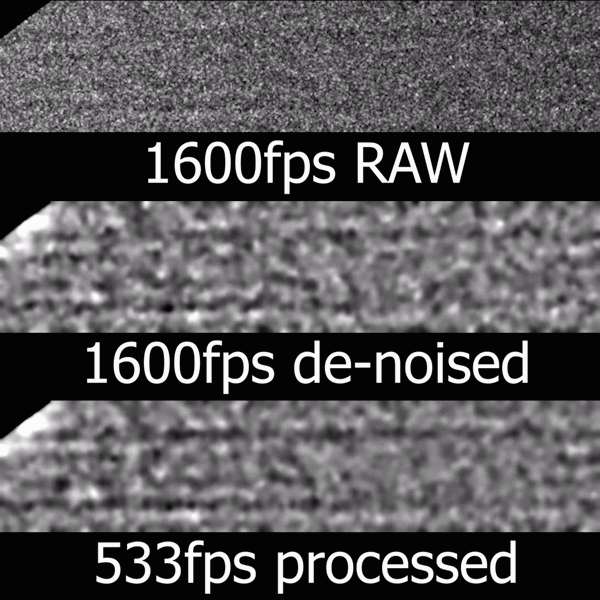A team including researchers from the Department of Chemistry at the University of Tokyo has successfully captured video of single molecules in motion at 1,600 frames per second. This is 100 times faster than previous experiments of this nature. They accomplished this by combining a powerful electron microscope with a highly sensitive camera and advanced image processing. This method could aid many areas of nanoscale research.
When it comes to film and video, the number of images captured or displayed every second is known as the frames per second or fps. If video is captured at high fps but displayed at lower fps, the effect is a smooth slowing down of motion which allows you to perceive otherwise inaccessible details. For reference, films shown at cinemas have usually been displayed at 24 frames per second for well over 100 years. In the last decade or so, special microscopes and cameras have allowed researchers to capture atomic-scale events at about 16 fps. But a new technique has increased this to a staggering 1,600 fps.
"Previously, we successfully captured atomic-scale events in real time," said Project Professor Eiichi Nakamura. "Our transmission electron microscope (TEM) gives incredible spatial resolution, but to see details of small-scale physical and chemical events well, you need high temporal resolution too. This is why we pursued an image capture technique that is much faster than earlier experiments, so we can slow down playback of the events and see them in a whole new way."

Noisy nanotubes. It's hard to make out, but with practice researchers can easily see molecules in motion. Image CC-0
Nakamura and his team used a TEM as it has the power to resolve objects smaller than 1 angstrom or one ten-billionth of a meter. They attached an imaging device called a direct electron detection (DED) camera. This camera is highly sensitive and is capable of high frame rates. However, even with this powerful microscope and sensitive camera, there is one enormous hurdle to overcome in order to obtain usable images: Noise.
"To capture high fps, you need an imaging sensor with high sensitivity, and greater sensitivity brings with it a high degree of visual noise. This is an unavoidable fact of electronic engineering," said Project Associate Professor Koji Harano. "To compensate for this noise and achieve greater clarity, we used an image-processing technique called Chambolle total variation denoising. You may not realize, but you have probably seen this algorithm in action as it is widely used to improve image quality of web videos."
The researchers tested their setup by imaging vibrating carbon nanotubes which housed fullerene (C60) molecules resembling faceted soccer balls made from carbon atoms. The imaging setup captured some mechanical behavior never seen before on the nanoscale. Like a pebble in a shaken maraca, the oscillating motion of the C60 molecule is coupled with the oscillation of the carbon nanotube container. This is only visible at high frame rates.
"We were pleasantly surprised that this denoising and image processing revealed the unseen motion of fullerene molecules," said Harano. "However, we still have a serious problem in that the processing takes place after the video is captured. This means the visual feedback from the experiment under the microscope is not yet real-time, but with high-performance computation this might be possible before too long. This could prove to be a very useful tool to those who explore the microscopic world."






